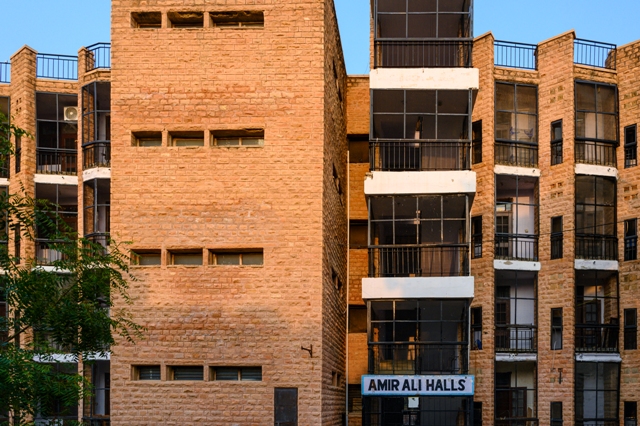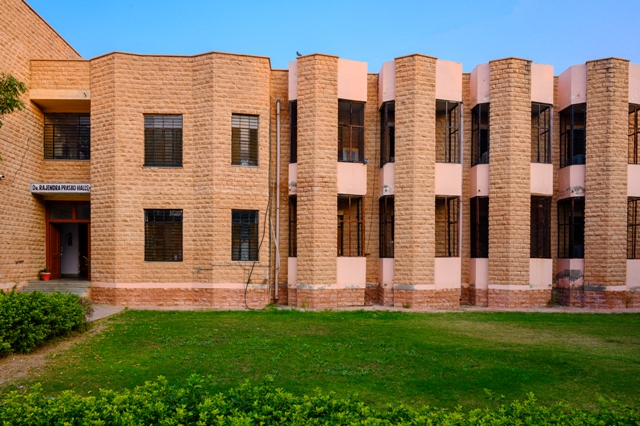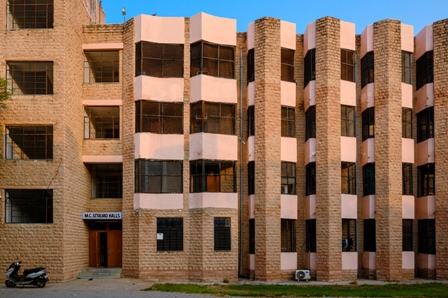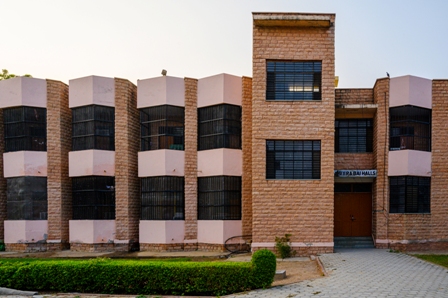Located on a 57-acre campus on the busy Jodhpur-Nagour Highway, NLU Jodhpur straddles and connects both a futuristic vision of the legal fraternity as well as preserves, as an academic repository, the country’s rich legal knowledge and disseminates the same amongst young prodigy. The architecture of the University leverages the salubrious surrounding environment to maximum advantage and showcases the concept of nurture in nature. The 12 Halls of Residence for the student fraternity have been appellated in honour of 12 Indian luminaries and by constant reminiscence, continue to inspire.
Proper hostel facilities are a direct ingredient of the well being of students. The University has placed immense premium not just on the infrastructure in the Halls of Learning but also in Halls of Residence.
Halls of Residence Boys:
Every student has been allotted individual rooms with adequate space for a cupboard and a table and chair with an attached balcony. The students are allowed to keep a cooler or air condition as per their convenience. Apart from these, a student can avail the facility of getting his room cleaned daily. The toilets and washrooms are shared in the hostels, with one compound for the same on every floor. Moreover, a water cooler has been placed in the pantry of every floor except the ground floor and the top floor. A woman who does the laundry regularly visits the hostels. Nonetheless, the students have also been allowed to purchase and operate a washing machine on each floor.
 Nagendra Singh Halls of Residence : Immortalizing the memory of Dr.Nagendra Singh, distinguished Judge of the International Court ofJustice, who served as its Vice-President (1976-1979) and President(1985-1988). Throughout his illustrious career Justice Singh was involved in diplomatic conferences as delegate to the SecondGeneva Conference on the Law of the Sea, Indian delegate to the U.N. Assembly, Chairman and delegate to numerous U.N. commissions and conferences on diverse areas such as trade and development,shipping and maritime matters, and uses of atomic energy.Justice Singh's scholarly accomplishments are reflected in his extensive academic writings.
Nagendra Singh Halls of Residence : Immortalizing the memory of Dr.Nagendra Singh, distinguished Judge of the International Court ofJustice, who served as its Vice-President (1976-1979) and President(1985-1988). Throughout his illustrious career Justice Singh was involved in diplomatic conferences as delegate to the SecondGeneva Conference on the Law of the Sea, Indian delegate to the U.N. Assembly, Chairman and delegate to numerous U.N. commissions and conferences on diverse areas such as trade and development,shipping and maritime matters, and uses of atomic energy.Justice Singh's scholarly accomplishments are reflected in his extensive academic writings.
 Amir Ali Halls of Residence : The premises are appellated in honour of Saiyid Amir Ali who was the first Indian nominated as a member of the Privy Council. Along with his political efforts and achievements Amir Ali is famous for his literary works. He was the author of two famous works one of which is the History of Saracens published in 1889 that tells the story of the rise and fall of Saracens. The other work is the Spirit of Islam published in 1891.
Amir Ali Halls of Residence : The premises are appellated in honour of Saiyid Amir Ali who was the first Indian nominated as a member of the Privy Council. Along with his political efforts and achievements Amir Ali is famous for his literary works. He was the author of two famous works one of which is the History of Saracens published in 1889 that tells the story of the rise and fall of Saracens. The other work is the Spirit of Islam published in 1891.
 Radha Binod Pal Halls of Residence: Named in honour of the only Indian member of International Military Tribunal of the Far East, set up for punishing the Japanese Military General and though inducted very late into the Tribunal, Radha Binod Pal remains etched in Japanese memory for his dissenting judgment which was more than 1230 pages in length.There is a monument dedicated to Justice Pal at Tokyo’s Yasukuni shrine, which commemorates Japanese war heroes.
Radha Binod Pal Halls of Residence: Named in honour of the only Indian member of International Military Tribunal of the Far East, set up for punishing the Japanese Military General and though inducted very late into the Tribunal, Radha Binod Pal remains etched in Japanese memory for his dissenting judgment which was more than 1230 pages in length.There is a monument dedicated to Justice Pal at Tokyo’s Yasukuni shrine, which commemorates Japanese war heroes.
 Dr. Rajendra Prasad Halls of Residence: Reminiscent of one of the chief architects of modem India, Dr. Rajendra Prasad was an eminent freedom fighter, a renowned jurist, an eloquent Parliamentarian, an able administrator, a statesman par excellence and above all, a humanitarian to the core. An ardent follower and a repository of the trust and confidence of Mahatma Gandhi, he represented all that is best in our culture. As President of the Constituent Assembly and subsequently as occupant of the highest office of the land consecutively for two terms, he played a very important role in shaping the destiny of the nation and left an indelible imprint on our national life and polity.
Dr. Rajendra Prasad Halls of Residence: Reminiscent of one of the chief architects of modem India, Dr. Rajendra Prasad was an eminent freedom fighter, a renowned jurist, an eloquent Parliamentarian, an able administrator, a statesman par excellence and above all, a humanitarian to the core. An ardent follower and a repository of the trust and confidence of Mahatma Gandhi, he represented all that is best in our culture. As President of the Constituent Assembly and subsequently as occupant of the highest office of the land consecutively for two terms, he played a very important role in shaping the destiny of the nation and left an indelible imprint on our national life and polity.
 Dr. S.Radhakrishnan Halls of Residence:Honouring the memory of Dr Sarvepalli Radhakrishnan, a name that resonates profoundly in the corridors of philosophy and education, continues to inspire generations all around the world. This exceptional scholar, educator, philosopher, and former President of India, carved out an unparalleled niche in his lifetime. Radhakrishnan transcended boundaries of knowledge, instilling a unique confluence of Western and Indian philosophical thought, thereby propelling a deeper understanding and appreciation of philosophy as a whole.
Dr. S.Radhakrishnan Halls of Residence:Honouring the memory of Dr Sarvepalli Radhakrishnan, a name that resonates profoundly in the corridors of philosophy and education, continues to inspire generations all around the world. This exceptional scholar, educator, philosopher, and former President of India, carved out an unparalleled niche in his lifetime. Radhakrishnan transcended boundaries of knowledge, instilling a unique confluence of Western and Indian philosophical thought, thereby propelling a deeper understanding and appreciation of philosophy as a whole.
 M.C.Setalvad Halls of Residence:Immortalizing the attainments of Motilal Chimanlal Setalvad- a true giant, acknowledged as such by his peers, whose exploits in the court are still recounted with much zest in bar rooms and law colleges across the country. As the first and longest serving Attorney General of India, MC Setalvad was in the thick of resolving the nation’s constitutional dilemmas. He appeared for the Government in a host of important and, at times, controversial cases. Chairing the first Law Commission of independent India, he not only advised the government on crucial reforms and legislation but also created a framework for the Commissions’ future functioning.
M.C.Setalvad Halls of Residence:Immortalizing the attainments of Motilal Chimanlal Setalvad- a true giant, acknowledged as such by his peers, whose exploits in the court are still recounted with much zest in bar rooms and law colleges across the country. As the first and longest serving Attorney General of India, MC Setalvad was in the thick of resolving the nation’s constitutional dilemmas. He appeared for the Government in a host of important and, at times, controversial cases. Chairing the first Law Commission of independent India, he not only advised the government on crucial reforms and legislation but also created a framework for the Commissions’ future functioning.
Halls of Residence Girls:
All the facilities mentioned for boys extend to the girl's hostel as well. The compound is built separately from the Boys Hostel, with a specific entry gate to ensure their safety and well being. Both hostels have sufficient proximity to the mess.
 Meera Bai Halls of Residence: Evoking the memories of one of the foremost Indian saints, Meera Bai whoas a young child considered herself wedded toLord Krishna. She was married into the royalfamily and yet continued tovenerate Lord Krishna as her husband. In the course of her unswerving devotionto Krishna, Meera disowned, defied andsubverted the normative pattern of valuesassociated with powerful and entrenchedinstitutions- family, marriage, caste, clan,royalty and even the realm of bhakti.Despite her disregard for societal norms,she was able to acquire a special kind ofhonour and reverence - distinct from thehonour derived through adherence to pre-dominant norms laid down by the contemporary political, social and religious elite.A perusal of Meera's life shows thatthere is a continuous conflict and confrontation between Meera's fiercely independent and single-minded devotion to Krishnaand the code of honour cherished by thesociety and polity in the erstwhileRajput state.
Meera Bai Halls of Residence: Evoking the memories of one of the foremost Indian saints, Meera Bai whoas a young child considered herself wedded toLord Krishna. She was married into the royalfamily and yet continued tovenerate Lord Krishna as her husband. In the course of her unswerving devotionto Krishna, Meera disowned, defied andsubverted the normative pattern of valuesassociated with powerful and entrenchedinstitutions- family, marriage, caste, clan,royalty and even the realm of bhakti.Despite her disregard for societal norms,she was able to acquire a special kind ofhonour and reverence - distinct from thehonour derived through adherence to pre-dominant norms laid down by the contemporary political, social and religious elite.A perusal of Meera's life shows thatthere is a continuous conflict and confrontation between Meera's fiercely independent and single-minded devotion to Krishnaand the code of honour cherished by thesociety and polity in the erstwhileRajput state.
 Gargi Halls of Residence:Invoking the memory of Gargi Vachaknavi, an ancient Indian female philosopher, daughter of sage Vachaknu, and born in the family of Garga, circa 800-500 BCE.
Gargi Halls of Residence:Invoking the memory of Gargi Vachaknavi, an ancient Indian female philosopher, daughter of sage Vachaknu, and born in the family of Garga, circa 800-500 BCE.
 Mother Teresa Halls of Residence:Felicitously paying homage to Mother Teresa of Calcutta (Gonxha Agnes Bojaxhiu) born in 1910. Journeying as a missionary to India, she laboured many years as a teacher before hearing the “call within the call,” “to give up all and follow Him into the slums—to serve Him in the poorest of the poor,” and so satiate the thirst of Jesus for salvation of souls by founding the Missionaries of Charity. She was beatified by Pope John Paul II on 19 October 2003, and was canonized by Pope Francis on 4 September 2016.Her legacy lives on today, across the globe, through the tireless work of the Missionaries of Charity.
Mother Teresa Halls of Residence:Felicitously paying homage to Mother Teresa of Calcutta (Gonxha Agnes Bojaxhiu) born in 1910. Journeying as a missionary to India, she laboured many years as a teacher before hearing the “call within the call,” “to give up all and follow Him into the slums—to serve Him in the poorest of the poor,” and so satiate the thirst of Jesus for salvation of souls by founding the Missionaries of Charity. She was beatified by Pope John Paul II on 19 October 2003, and was canonized by Pope Francis on 4 September 2016.Her legacy lives on today, across the globe, through the tireless work of the Missionaries of Charity.
 Sarojni Naidu Halls of Residence:Immortalizing the attainments of poet, freedom-fighter, activist, orator and administrator, Sarojini Naidu who is also remembered as ‘The Nightingale of India’. Naidu was one of the first women to participate in India’s struggle for independence from the British. She was the first female president of the Indian National Congress and after independence, became the first woman Governor of Uttar Pradesh.Throughout her career, Naidu worked for the dignity of the common man and the education and emancipation of women by actively encouraging the setting up of orphanages and schools for girls. She also urged the student community to stand united against racial and communal discrimination.
Sarojni Naidu Halls of Residence:Immortalizing the attainments of poet, freedom-fighter, activist, orator and administrator, Sarojini Naidu who is also remembered as ‘The Nightingale of India’. Naidu was one of the first women to participate in India’s struggle for independence from the British. She was the first female president of the Indian National Congress and after independence, became the first woman Governor of Uttar Pradesh.Throughout her career, Naidu worked for the dignity of the common man and the education and emancipation of women by actively encouraging the setting up of orphanages and schools for girls. She also urged the student community to stand united against racial and communal discrimination.
 Rani Laxmi Bai Halls of Residence:Paying homage to the valour of Rani Lakshmibai or Jhansi ki Rani, the queen of Jhansi who was one of the leading figures of the First Battle of Independence in 1857. For Indian nationalists, she became an icon for the freedom struggle against the British Raj for Indian.She was a rare combination of bravery, intelligence and administrative ability.Almost a century after her death, the Indian National Army formed an all-female unit that aided the country in its battle for independence in the 1940s.It was called the Rani of Jhansi regiment.
Rani Laxmi Bai Halls of Residence:Paying homage to the valour of Rani Lakshmibai or Jhansi ki Rani, the queen of Jhansi who was one of the leading figures of the First Battle of Independence in 1857. For Indian nationalists, she became an icon for the freedom struggle against the British Raj for Indian.She was a rare combination of bravery, intelligence and administrative ability.Almost a century after her death, the Indian National Army formed an all-female unit that aided the country in its battle for independence in the 1940s.It was called the Rani of Jhansi regiment.
 Anna Chandy Halls of Residence:The premises honour the memory of Justice Anna Chandy who became India’s first female judge in 1937 and the first woman in the country to become a High Court judge in 1959.During her tenure as a judge of the Kerala High Court, she passed a number of important judgments, which reflected a profound understanding of the law as well as an unwavering emphasis on the dignity of the individual and the rights of the accused. After an illustrious career as a lawyer and a judge, she strove to bring about reforms in society through her service as a member of the Kerala Law Commission.
Anna Chandy Halls of Residence:The premises honour the memory of Justice Anna Chandy who became India’s first female judge in 1937 and the first woman in the country to become a High Court judge in 1959.During her tenure as a judge of the Kerala High Court, she passed a number of important judgments, which reflected a profound understanding of the law as well as an unwavering emphasis on the dignity of the individual and the rights of the accused. After an illustrious career as a lawyer and a judge, she strove to bring about reforms in society through her service as a member of the Kerala Law Commission.